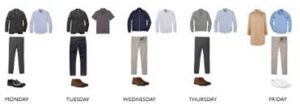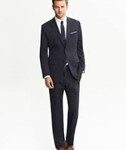- HOME
- About Us
- COURSES
- Campus Life
- Gallery
- Blogs
- Events
- Contact
FASHION 9 to 5

What is the office uniform code?
The office dress code refers to the level of formality you can wear to work. Most organizations don’t write rules about what their employees should wear. Instead, use generic terms such as “business professional,” “business suit,” “business casual,” and “casual.” By learning more about these categories and determining which categories apply to your workplace, you can excel in the way you dress.


How to Dress Like a Business Professional Professionalism
In business is the most conservative dress code in the office. This traditional business attire is everyday work wear in industries such as finance, banking, government and law. A suit or trousers and a button-down shirt (usually with a tie) or a pencil skirt and knee-length blazer are business attire requirements. Beautiful ballet flats, loafers and oxfords are also suitable.




How to dress respectfully to work
A professional version of business attire is a suit. Black suit or skirt, shirt and dress shoes. Neckties and square pockets must be silk. Complete the look with a minimal belt and simple jewellery or cufflinks. How to Dress Casually for Work Business attire doesn’t necessarily mean casual.
How to Dress Casually for Business
Business casual doesn’t necessarily mean casual. It means you don’t actually have to wear a suit and tie. Business casual work attire typically includes a collared shirt (buttoned-up or polo shirt) or sweater over, trousers, khakis, chinos, or a pencil skirt underneath. You can add a blazer or sport coat, but you don’t necessarily need a tailored jacket. Whether you choose boots, heels, flats, moccasins, mules or oxfords, your footwear should be closed and professional.
How to Dress Casually at Work
A casual office dress code is less strict than a business dress code, but that doesn’t mean you have to dress as casually as you do outside of work. To maintain a professional look for everyday wear, look for button-down shirts, solid colour blouses and t-shirts, and dark or black jeans with no rips or holes. Clean sneakers are fine, but wear closed-toe shoes and always avoid slippers.
Casual and smart casual at work
Smart casual is an upgraded version of casual that is generally more suitable for job interviews, customer meetings, and casual workplace events. For the smart casual dress code, wear trendy items such as work clothes, blazers and stylish shoes. To feel satisfied and productive in your career, your work environment must match your personality type. A professional environment should provide a positive atmosphere characterized by effective communication, appropriate resources and career opportunities. Diverse working environment
The work environment is also influenced by values, personality type, and work type. Here are six types of work environments suitable for a variety of people and professions.
- Working environment of general experts
A typical work environment is well-structured and organized and includes systematic activities such as working with data and numbers. These environments are characterized by routine, stability, tradition, and well-defined rules and procedures. This work environment typically includes office work and regular hours. Jobs that fit well in the work environment of the competition:
Key Roles: the Minister, also known as the Administrative Secretary, performs administrative tasks such as registration, answering calls, sending e-mails and faxes, keeping records and organizing courier services. Because these professionals typically work at the company’s front desk, they also greet and assist customers, so you must act professionally and respectfully at all times. This task requires organizational, communication, and computer skills. Managers typically work 40 hours per week, with very little overtime.
- Entrepreneurial Professional Work Environment
Entrepreneurial work environments focus on achieving organizational and financial goals and typically include activities such as persuasion, management, and selling. These environments are characterized by competition, achievement, power, money, competition, and may include activities such as sales and management. People who thrive in such work environments are usually outgoing, ambitious, and assertive. Tasks compatible with this environment:
Key Role: Sales managers lead the organization’s sales department. Their responsibilities include hiring new sales staff, planning sales strategies, mentoring and training employees, preparing budgets and managing costs. Sales managers need good interpersonal, leadership and communication skills as they have to work not only with their own team, but also with other departments such as marketing, customers and suppliers.
- Work environment for social experts
The social work environment is people-centred and includes activities related to teaching, guiding, healing, and understanding people. You must have great communication, language and interpersonal skills. These environments may include working in an office, working in the field, consulting with clients, teaching at a school or university, or working in a hospital. Tasks in this category:
Key Role: Social workers help communities and people facing challenges in everyday life, such as unemployment, abuse, poverty, addiction, or divorce. For example, in the case of child abuse, a social worker may step in and arrange for the child to be removed and placed in foster care. These professionals require good interpersonal and communication skills, as well as empathy and emotional intelligence. Social workers may work in offices, schools, or visit clients and communities.
- Work environment for creative professionals
The artistic work environment is unplanned and emphasizes freedom of expression, creativity, aesthetics, imagination and originality. People who are drawn to such environments are generally unconventional, free-spirited, intuitive, and goal-oriented. These work environments may include theatre productions, musical performances, design work, writing, and artistic creation. Examples of tasks in this category:
Key role: Fashion designers are creative people who study fashion trends and create their own clothes or accessories. Their work includes sketching new designs and building first prototypes that include pattern making, fabric selection, sewing, and fitting. Working independently, fashion designers are expected to promote their creations by organizing runway shows and showcasing their work on websites and social media. These professionals must be creative, visually minded, and have a sense of fashion. They may work for manufacturing companies, they may work full-time or for themselves. This will take a long time and the ability to sell yourself and your designs.
5. Investigator Environment
The research environment is focused on math and science and includes problem solving, creative and abstract thinking.
Those who thrive in such an environment are innovative thinkers who prefer to work with their minds rather than deal with pragmatic and physical tasks. This environment includes working in the laboratory. Computer programming; Engage in statistical, scientific or mathematical work and archaeology. Examples of work in this category:
Primary Role: Research Scientists conduct experiments and conduct research in specific scientific fields such as medicine, environmental sciences, food sciences, or biological sciences. Their work also includes writing articles, developing research proposals, and collaborating with other researchers to create final products. These professionals require excellent analytical, interpersonal and writing skills.
6. Realistic job environment
The realistic environment focuses on manual tasks that include the use of tools, utensils, and implements, and may also include animals, plants, and outdoor work. People who enjoy working with their hands and focusing on the present thrive in these environments. Example working in this environment:
Primary Role: Plumbers install and repair piping systems and accessories. Their daily work also includes troubleshooting the site and connecting pipes and installing drainage systems according to the water supply system plan. This job can be physically demanding, so plumbers need strength and dexterity. Other skills include customer service, analytical skills, and problem-solving skills.

